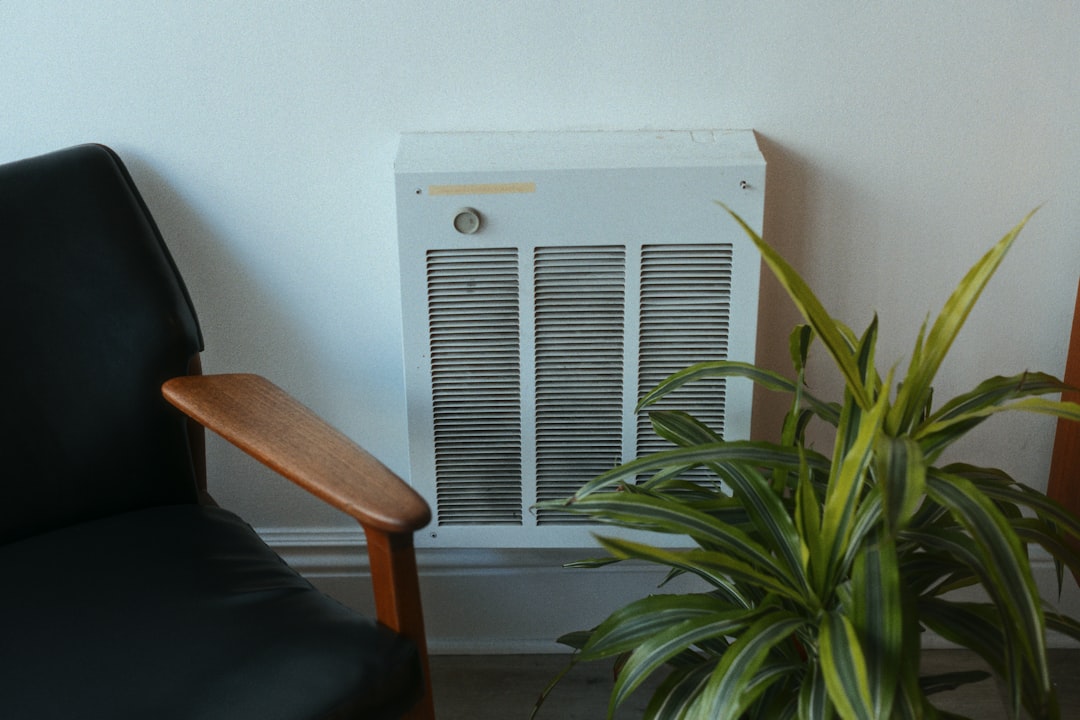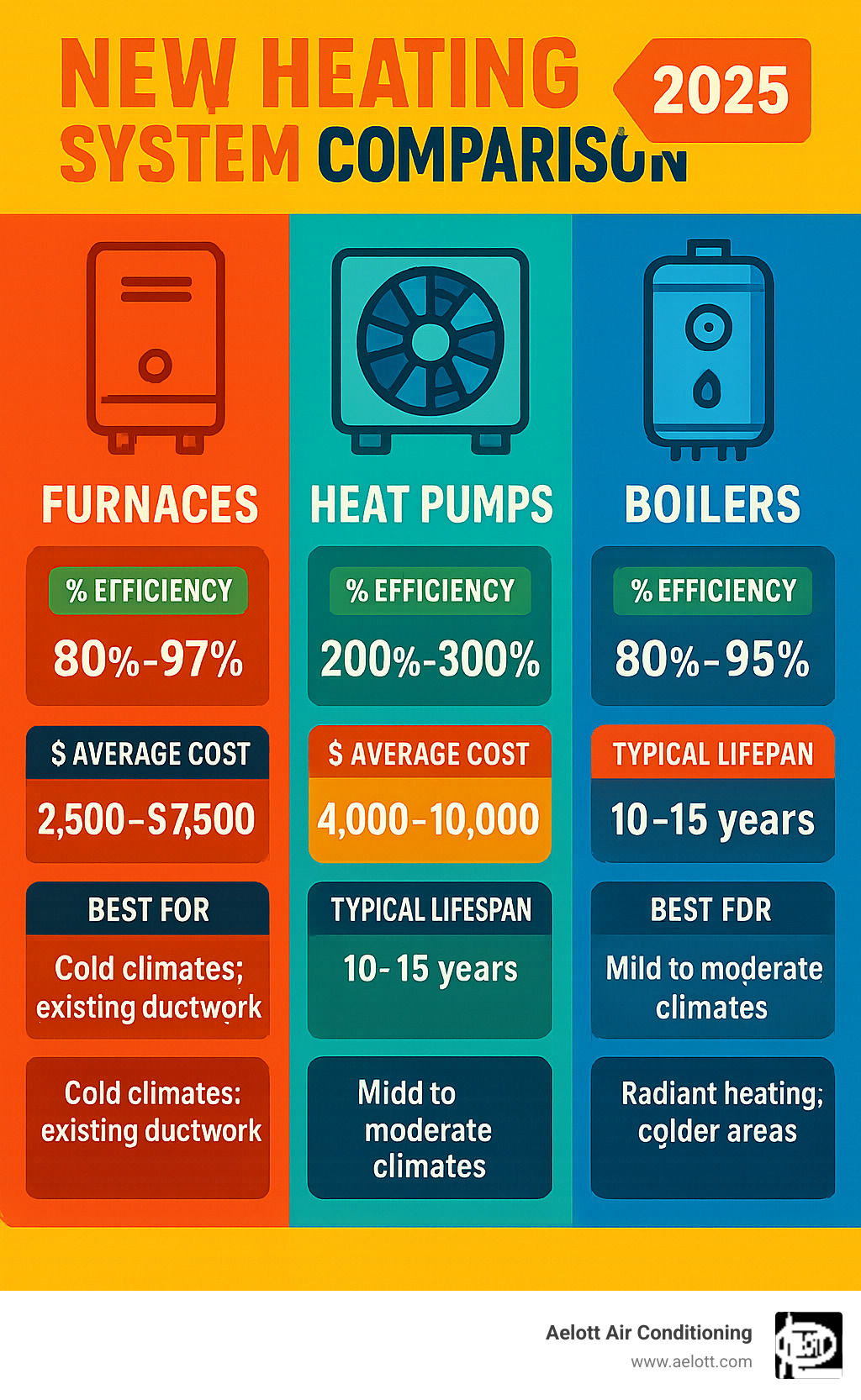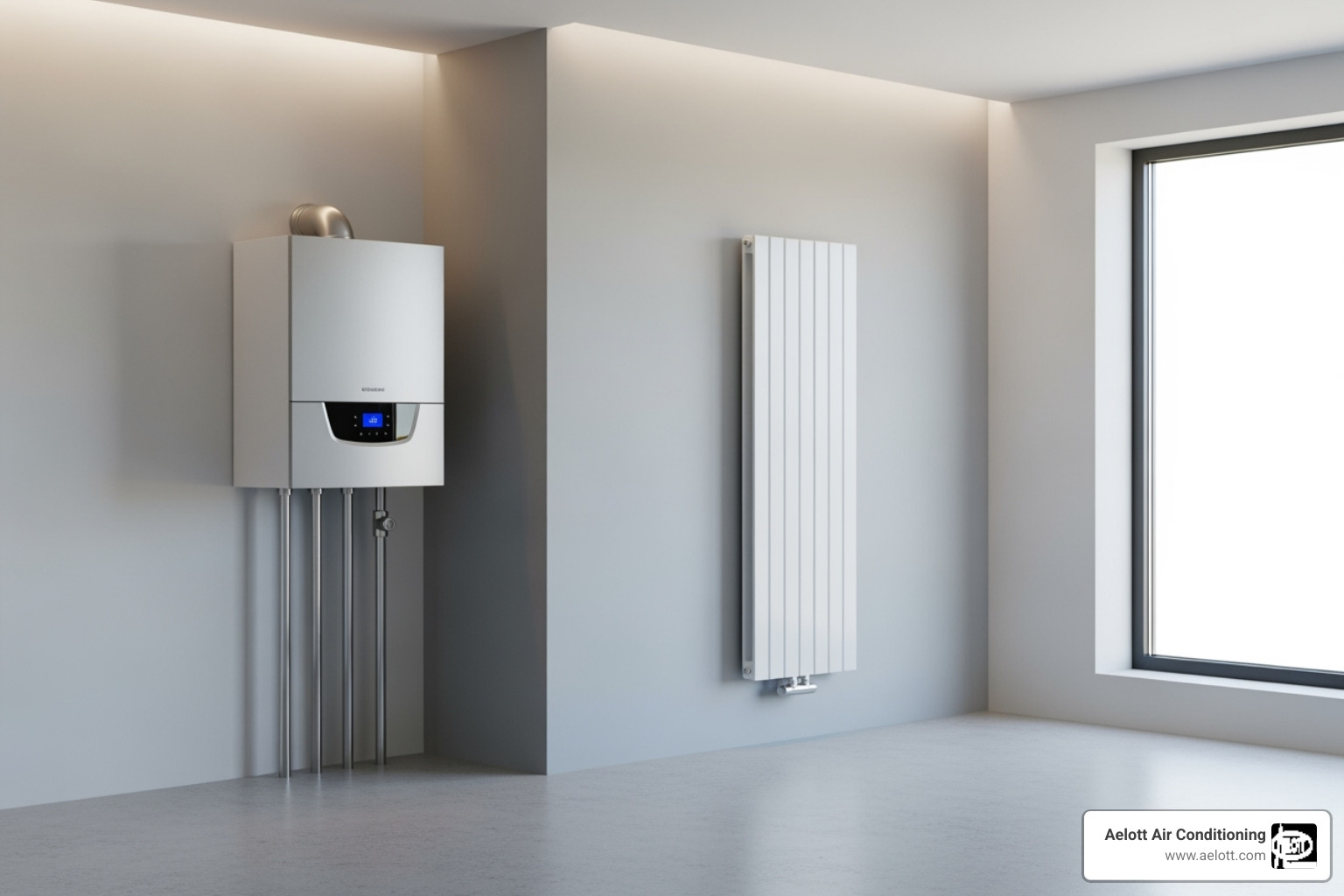.webp)
.webp)
Beyond the Chill: Finding the Perfect New Heating System for Your Home
Find your ideal new heating system. Compare types, costs, efficiency & maintenance to lower bills & boost comfort. Get expert advice.

Why Your Home's Heating System Is the Key to Comfort and Savings
A new heating system is a major investment and often the single biggest energy user in a home. With heating accounting for about 29% of the average utility bill, choosing wisely is crucial.
Quick Guide to New Heating System Options:
- Furnaces: Most common choice, use gas/electric/oil, require ductwork, cost $2,500-$7,500 installed
- Heat Pumps: Provide heating and cooling, very efficient in moderate climates, cost $4,000-$10,000
- Boilers: Create radiant heat through hot water/steam, last longest, cost $3,500-$8,000
- Other Options: Ductless mini-splits, hybrid systems, solar heating for specific needs
Upgrading to a modern, efficient system can save you about 30% on energy bills, especially with proper insulation and maintenance. Most systems fall into three price ranges: basic ($2,500-$5,000), mid-range ($5,000-$8,000), and high-end ($8,000-$12,000+).
Your choice depends on your home's size, ductwork, local climate, and fuel availability. For North County San Diego's moderate climate, heat pumps are a great option, while colder areas favor high-efficiency furnaces.
If your system is over 15 years old, making strange noises, or heating unevenly, replacement often makes more financial sense than endless repairs.

Exploring Your Options: A Guide to Modern Heating Systems
Shopping for a new heating system can feel overwhelming. Let's break down the main options to help you find the perfect match for your home.
Furnaces (Forced Air Systems)
Furnaces are the most popular heating system in America. They work quickly, and most homes already have the necessary ductwork.

A furnace heats air, and a powerful fan pushes it through ducts to warm your home.
Gas furnaces are popular and cost-effective where natural gas is available, like North County San Diego. Electric furnaces are an alternative where gas isn't an option, though they can be more expensive to run. Oil furnaces are less common and require on-site fuel storage.
Furnaces provide fast heat and can use the same ductwork as your air conditioning system. The main drawbacks are the cost of installing new ductwork and the potential for dry air in winter.
Keep your furnace running smoothly with regular maintenance. If you're noticing unusual sounds or uneven heating, check out our guide: The Top Signs Your Furnace Needs Maintenance.
Heat Pumps
Heat pumps are highly efficient, all-in-one systems that heat your home in winter and cool it in summer.
Instead of creating heat, they move it. In winter, they pull heat from the outside air into your home. In summer, they reverse the process to cool your home.
Air-source heat pumps are ideal for moderate climates like San Diego. Geothermal heat pumps are even more efficient, using stable underground temperatures, but have a higher upfront cost due to ground loop installation.
Because they move heat instead of creating it, heat pumps can be three to four times more efficient than traditional systems, leading to significant utility savings. Drawbacks include reduced performance in extreme cold and a higher upfront cost, though long-term energy savings often offset this.
If your current heat pump isn't keeping you comfortable, our team can help: Heating Repair in San Marcos, CA.
Boilers (Hydronic Systems)
Boilers provide gentle, consistent radiant heat throughout your home.

Boilers heat water that circulates through pipes to radiators, baseboard heaters, or underfloor heating. This creates consistent radiant heat that warms objects directly. Radiant heat is quiet, draft-free, and excellent for allergy sufferers as it doesn't circulate dust.
The trade-offs are a slower response time compared to forced-air systems and the need for a separate air conditioning system. While they take longer to heat up, boilers are incredibly durable and can last for decades.
Other Heating Solutions
Ductless mini-splits are perfect for additions or spaces without ductwork, offering excellent zoned heating. Hybrid systems pair an electric heat pump with a gas furnace, automatically switching to the most efficient fuel source to maximize savings. Active solar heating uses the sun's energy to heat your home; it's a niche application with a high upfront cost but offers significant long-term environmental benefits and savings.
Each of these systems has its place, and the right choice depends on your home's unique characteristics, your local climate, and what matters most to you in terms of comfort, efficiency, and cost.
Understanding the Cost of a New Heating System
The price of a new heating system can be daunting, but understanding the cost factors helps you make a smart investment. Like cars, heating systems vary in price based on type and features.
Average Installation Costs by System Type
Here are some ballpark figures for equipment and professional installation:
| System Type | Basic Systems Cost | Mid-Range Systems Cost | High-End Systems Cost |
|---|---|---|---|
| Furnaces | $2,500 – $4,500 | $4,500 – $6,500 | $6,500 – $7,500+ |
| Heat Pumps | $4,000 – $6,000 | $6,000 – $8,000 | $8,000 – $10,000+ |
| Boilers | $3,500 – $5,000 | $5,000 – $6,500 | $6,500 – $8,000+ |
Basic systems offer standard efficiency at a lower price. Mid-range systems balance cost with better efficiency and features. High-end systems provide top-tier efficiency and smart home integration for maximum long-term savings.
Key Factors When Choosing a New Heating System
Several factors influence your upfront cost and long-term satisfaction with your new heating system.
System size (measured in BTUs) is crucial. An undersized system will struggle, while an oversized one will waste energy. A professional load calculation is essential to determine the right size for your home.
Home layout affects installation complexity. Installation is simpler and cheaper in a single-story home with existing ductwork than in a multi-story house needing new ductwork.
Insulation quality is key. Poor insulation forces your system to work harder and increases costs. Upgrading insulation first can be a smart move.
Local climate shapes your choice. A heat pump is efficient in Escondido's moderate climate, while a robust furnace is better for colder regions.
Installation complexity is a major variable. Removing old equipment, electrical upgrades, permits, and new ductwork all add to the cost, highlighting the need for an experienced installer.
For professional installation you can trust, explore our services: Heating Installation in Carlsbad, CA.
How Fuel Type and Efficiency Ratings Impact Your Wallet
Your system's fuel type and efficiency rating will determine your monthly energy bills.
Natural gas is typically the most economical and popular choice where available. Electric systems are clean and easy to install; in moderate climates, high-efficiency electric heat pumps can be cheaper to run than gas. Oil heating provides strong heat but requires on-site storage and faces price volatility.
Efficiency ratings predict operating costs. Look for AFUE (Annual Fuel Utilization Efficiency) for furnaces/boilers, and HSPF (Heating Seasonal Performance Factor) or COP (Coefficient of Performance) for heat pumps.
Higher efficiency systems cost more upfront but lead to lower monthly bills. The key is finding the right balance for your budget and long-term savings.
For detailed explanations, check out this resource: Home heating efficiency ratings explained by the U.S. Department of Energy.
The bottom line? Investing in the right system now – properly sized, efficiently rated, and professionally installed – pays dividends in comfort and savings for decades.
The Long-Term Value: Benefits, Lifespan, and Maintenance
A new heating system is a long-term investment in your home's comfort and value. Let's explore the benefits, lifespan, and maintenance needs.
Key Benefits of Upgrading Your System
Upgrading to a modern system dramatically improves energy efficiency, converting more fuel into heat. This efficiency leads to lower utility bills, with potential savings around 30% when combined with proper home sealing and a smart thermostat.
Beyond savings, you'll enjoy improved home comfort. Modern systems provide even heat distribution, eliminating cold spots. A new system can also improve indoor air quality, as advanced filters capture dust and allergens.
A modern, efficient HVAC system increases property value and reduces environmental emissions by consuming less energy. Finally, enjoy the peace of mind that comes with a reliable new system, avoiding unexpected breakdowns on cold nights.
What is the Typical Lifespan of Different Heating Systems?
Different heating systems have different expected lifespans. Quality installation, regular maintenance, local climate, and brand quality all affect longevity.
- Furnaces: Typically last 15-20 years with proper care.
- Boilers: Built to last 20-35 years or even longer.
- Heat pumps: Provide year-round heating and cooling, so they typically last 10-15 years.
What Maintenance Does My New Heating System Need?
Proper maintenance is key to your new heating system's longevity and performance. Think of it as an insurance policy against costly future repairs.
Annual professional tune-ups are essential. Schedule one in the fall for a technician to inspect, clean, and test all components to ensure safety and efficiency.
For forced-air systems, filter changes are your most important task. Check your filter monthly and replace it every 1-3 months. A dirty filter restricts airflow and forces your system to work harder.
Keep vents and registers clean and unobstructed by furniture or rugs to ensure proper airflow. Also, ensure your thermostat is working correctly; a smart thermostat can improve control and savings.
For expert maintenance, consider our Furnace Tune-Up in Escondido, CA service. It's also wise to know what to watch for between service calls: Heating System Problems to Look Out For This Winter.
Saving Money on Your Upgrade: Rebates and Incentives
A new heating system is a major investment, but you don't have to bear the full cost. Numerous rebates, tax credits, and incentives are available to help you upgrade to a more efficient system, saving you money and reducing energy consumption.
Finding Federal, State, and Local Rebates
Finding incentives requires some research, but it can lead to significant savings. To maximize your savings, research early, as many programs are seasonal or have limited funding.
ENERGY STAR Certified Systems: Look for the ENERGY STAR label when shopping. These systems meet strict federal efficiency guidelines and are often required for rebates.
Federal Tax Credits: These can directly reduce your income tax bill for installing high-efficiency equipment. These programs change, so check for the latest information.
State and Local Governments: Your state, county, or city may offer their own grants, loans, or incentives for energy-efficient upgrades.
Utility Company Programs: Check with your local utility company. They often provide direct rebates for qualifying systems to help reduce strain on the power grid.
Manufacturer Rebates: Manufacturers also offer seasonal rebates on specific models, which can often be combined with other incentives.
These incentives create a win-win: you save money, and the community benefits from reduced energy consumption. This makes your new heating system upgrade even more attractive.
For comprehensive information, the U.S. Department of Energy provides excellent resources: Information on home heating systems from the U.S. Department of Energy.
Frequently Asked Questions about New Heating Systems
Considering a new heating system brings up many questions. Here are answers to the most common ones we hear.
What is the most energy-efficient heating system?
Geothermal heat pumps are the most energy-efficient, using the earth's stable underground temperatures. However, they have a very high upfront cost and are not suitable for every property.
In colder climates with natural gas, high-efficiency natural gas furnaces (95%+ AFUE) offer excellent value. For North County San Diego's moderate climate, air-source heat pumps are an excellent, efficient choice for both heating and cooling.
The most efficient system is ultimately the one that best fits your home, climate, and budget.
How do I know what size heating system I need?
Sizing a new heating system is a precise science that requires a professional. A qualified technician performs a "Manual J" load calculation, a comprehensive analysis of your home.
This calculation considers your home's size, layout, insulation, windows, doors, and local climate. Correct sizing is critical. An undersized system will run constantly and wear out, while an oversized system wastes energy and controls humidity poorly.
The result is the precise BTU (British Thermal Unit) output your home needs for optimal performance. This professional calculation is the foundation of a successful heating system installation.
Can I install a new heating system myself?
No. While DIY projects can be satisfying, installing a new heating system is a job for professionals due to safety and complexity.
Safety is the primary concern. Installation involves high-voltage electricity, natural gas lines, and potentially hazardous refrigerants. Improper installation can lead to fires, leaks, or carbon monoxide poisoning.
Performance is also key. Proper calibration, duct sealing, and refrigerant charging require specialized tools and expertise to ensure your system runs efficiently.
Most manufacturer warranties are voided by DIY installation. The initial savings aren't worth losing warranty coverage for future repairs.
Finally, professionals ensure the installation meets all local building codes, avoiding potential fines and issues when selling your home. The bottom line: Professional installation ensures your new heating system is safe, efficient, and reliable. It's not a DIY project.
Your Partner for a Warmer, More Efficient Home
Choosing a new heating system is a major decision that impacts your home's comfort and budget for years. It's an investment in your family's comfort, your home's efficiency, and your peace of mind.
You now understand the differences between furnaces, heat pumps, and boilers, as well as the costs, efficiency ratings, and maintenance involved. This knowledge empowers you to make a smart choice. However, even the best system requires expert installation to perform correctly. The right team makes all the difference.
For homeowners throughout Escondido, Carmel Mountain, Del Mar, Bonsall, Encinitas, Vista, Oceanside, Carlsbad, San Marcos, Poway, Kearny Mesa, Valley Center, Solana Beach, Rancho Santa Fe, Rancho Bernardo, Ramona, Miramar, La Jolla, Fallbrook, North County San Diego, and all of San Diego County, you want a partner you can trust.
Since 1963, Aelott Air Conditioning has helped homeowners find perfect heating solutions. With six decades of experience in our Southern California climate, we offer honest pricing, decades of real experience, and a 100% satisfaction guarantee.
We take the time to understand your unique needs, budget, and preferences. You'll get honest advice without high-pressure sales tactics. When you're ready for a warmer, more efficient home, we'll guide you through the entire process, from selection to perfect installation, ensuring your new heating system delivers the comfort and savings you expect.

Customer Testimonials
Go With Experience

HVAC Financing Available!
Get 0% Financing for 12 Months with Deferred Interest! Enjoy no payments and no interest on select plans.


Latest Blogs

.avif)
How to Run Your Furnace Efficiently: A Guide to Staying Warm This Winter








